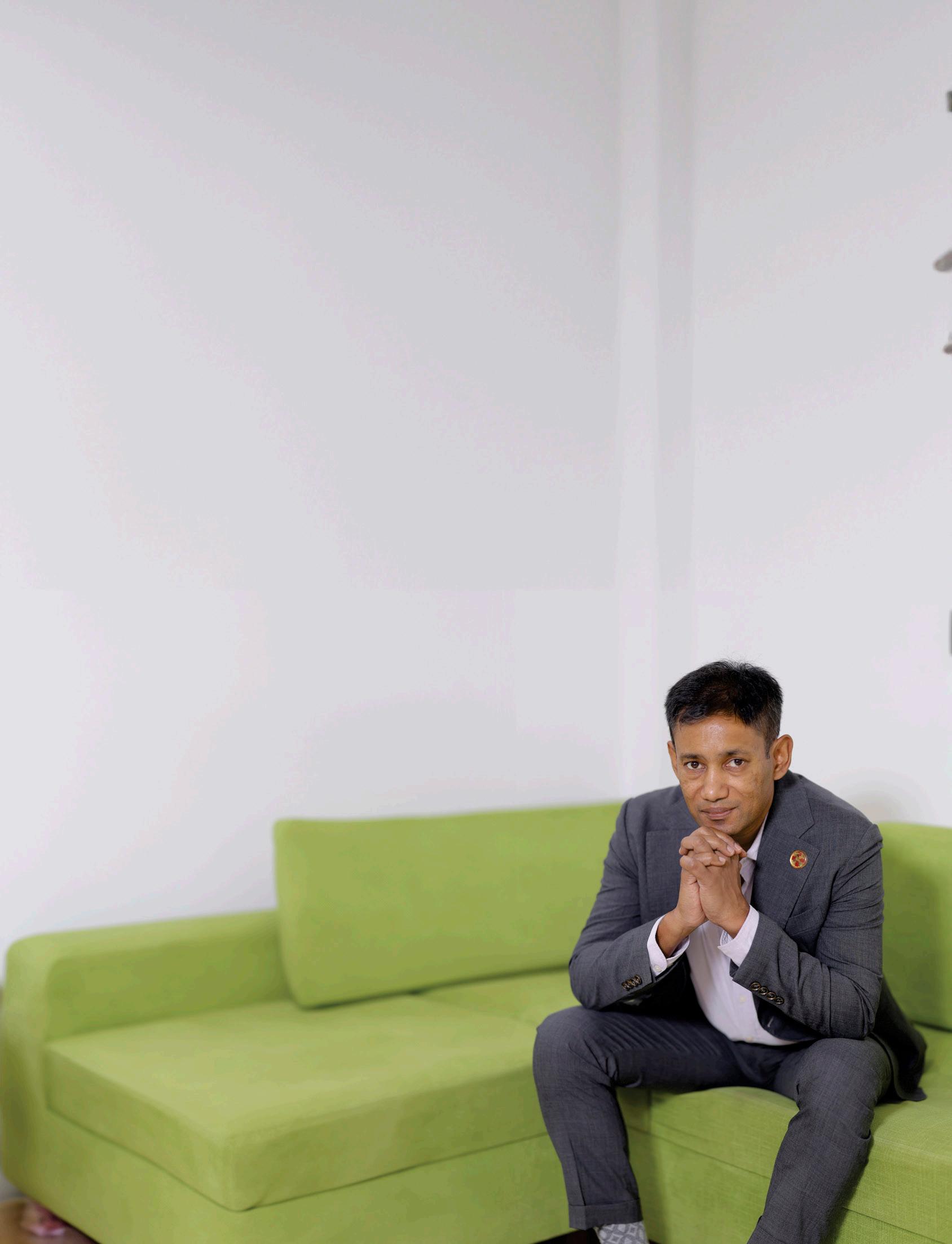If you are the FIRST RESPONDER!
Dr. Biswaroop Roy Chowdhury



Dr. Biswaroop Roy Chowdhury


Dr. Biswaroop Roy Chowdhury is the creator of the Mathematical Model of nutrition, known as the DIP diet, which has been proven e�ective in diabetes, hyper tension, obesity, bone diseases, and chronic kidney diseases through clinical trials in India (Ayush Ministry), Nepal (National Health Ministry), and Malaysia (Lincoln University). Fur thermore, he received the Innovation Award – 2024 (WASME & Ethiopian Embassy) for his gravity & heat-based invention, the GRAD system, to reverse chronic kidney diseases. His 3 Step �u diet is found to be e�ective in treating severe & moderate patients of covid-�� (in�uen�a like illness /ILI) by N.I.N., Ministry of Ayush and is adapted as a par t of text book by CRC Press (Taylor & Francis)

Dr. Biswaroop Roy Chowdhury, an engineering graduate, holds postgraduation in Diabetes and PhD (Hon.) in Diabetes & Chronic Kidney Disease. With an impressive por tfolio of 32 published books, he successfully oversees the HIIMS group of Hospitals & Medical Academy which actively engage in healthcare endeavours across India, Vietnam, Malaysia and Nepal.
§ Acupressure
§ Ayurveda
§ Naturopathy
§ Postural Medicine
: . . /

Dr. Biswaroop Roy Chowdhury
©Copyright Dr. Biswaroop Roy Chowdhury
India Office:
C/o India Book of Records
413A, HSIIDC, Sector-68, IMT, Faridabad-121004, Haryana, India
Ph.: +91-93122 86540
Vietnam Office:
C/o RICHS (Research Institute of Complementary Health Sciences)
01 Dang Van Ngu St, 10th Ward, Phu Nhuan Dist, HCM city, Vietnam
Malaysia Office: Bishwaroop International Healing & Research Sendirian Berhad (1210164U)
No. 66A, Damai Complex, Jalan Lumut, Off Jalan Ipoh, 50400 Kuala Lumpur, Malaysia.
Switzerland Office:
C/o Nigel Kingsley Kraftwerkstr. 95, ch-5465, Mellikon, Switzerland
Facebook: https://www.facebook.com/drbiswarooproychowdhury
YouTube: https://www.youtube.com/@drbiswarooproychowdhury
Twitter: https://twitter.com/drbrc_official
Bitchute: https://www.bitchute.com/channel/drbiswarooproychowdhury
Instagram: https://www.instagram.com/drbrc.official
Telegram: https://t.me/drbiswarooproychowdhury
Email: biswaroop@biswaroop.com
Website: www.biswaroop.com
Video Channel: www.coronakaal.tv
Edition: July 2024
Research: Rachna Sharma
Graphics Designer: Swapan Banik
Video Transcription: Sanjana Bhowmick
Technique Compilation: Kalpana Bourai–Sr. Nutritionist, Dr. Anamika Singh–BPT, Dr. Anu Bhardwaj–BAMS, PGDIP, Dr. Namita Gupta–MBBS, MD, Dr. Sanju Khari–BDS, Dr. Antim Kumar Jain (PhD in Yoga & Acupuncture)
Published by

X-30, Okhla Industrial Area, New Delhi-110020
Ph: +011-40712100 email: sales@dpb.in website: www.diamondbook.in
Dedicated to my angel daughter Ivy, loving wife Neerja & caring parents
Shri Bikash Roy Chowdhury
Shrimati Lila Roy Chowdhury
*Taken from the video ‘2 hrs free online training on Emergency

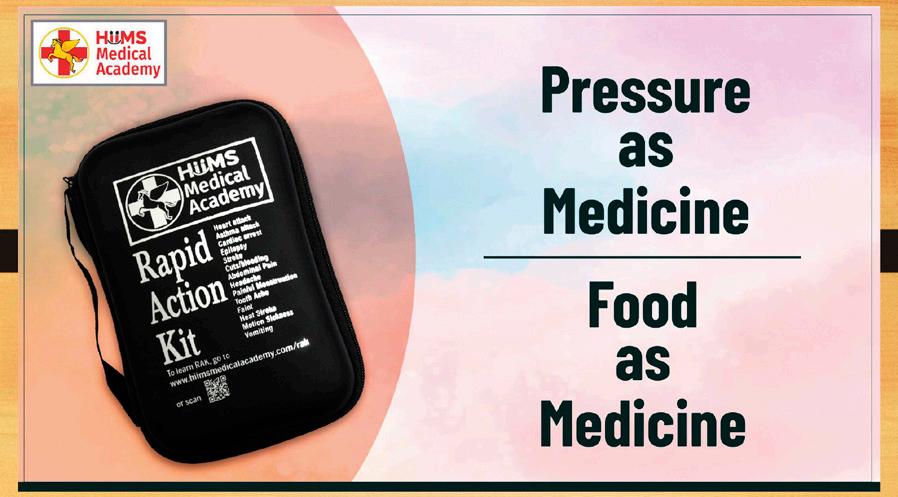
In the current scenario, especially post-COVID-19, we are witnessing a significant increase in medical emergencies such as cardiac arrest, heart attack, and brain stroke. These emergencies can happen anywhere – at the office, school, gym, home, or even on the road. Therefore, it is crucial for individuals, particularly first responders, to be knowledgeable about protocols for handling such situations.
This evidence-based pocket guide is the first of its kind. Its compact size is designed for easy portability, allowing you to carry it conveniently in your pocket.
This guidebook functions as a video book, enabling you to watch videos of the protocols to understand and learn the emergency techniques effectively. We recommend creating a Rapid Action Kit and keeping it in your car, home, or office, or carrying it in your bag at all times. If you are unable to make the kit yourself, you can purchase it from us at www.biswaroop.com/shop.
There has been a sudden increase in heart attack cases following the Covid-19 vaccine. The reports and news coverage on this are indeed very concerning. So, what would you do if you, God forbid, ever face such an emergency? How would you handle situations like a heart attack, asthma attack, seizures, cardiac arrest, or a severe cut as a first responder? Most people would feel helpless, thinking only of rushing the patient to the hospital.
Always remember, in any medical emergency, the first 20 minutes are crucial. Can you reach the hospital within 20 minutes, or will the treatment start immediately upon arrival? The chances are nearly zero. Even if you ask any doctor for advice on handling such emergencies, they will likely tell you to take the patient to the hospital. Are there any tools, equipment, or medicines in hospitals that significantly increase survival or cure rates?
| If you are the FIRST RESPONDER!
It has been observed in war that 90% of deaths occur due to excessive bleeding when a soldier is wounded. Similarly, if someone experiences cardiac arrest and intervention does not appear within the first 4 minutes, he is likely to die.
This is where “Pressure as Medicine” comes in. In this book, we will discuss two kinds of medicines that even a novice in medical interventions can use during emergencies.
This book will teach you the fastest, safest, easiest, and most evidence-based techniques to save a person’s life during an emergency. All you need is a Rapid Action Kit, which you will learn to make in the following chapter. You need “Pressure as Medicine,” which requires only your hands. For instance, if someone has tachycardia, an extremely high pulse rate between 100 and 200, it may lead to palpitation or a heart attack. You can use “Pressure as Medicine” to lower the high pulse rate in such cases. Even in cases of cardiac arrest, where there is no breathing or pulse, “Pressure as Medicine” can be effective.
Applying pressure to the right place is crucial. This book teaches you how to do this. It is always a tense situation during emergencies, and people tend to forget even the simplest techniques. Therefore, the techniques
in this book are simple and memorable. We will use fewer medical terminologies and provide easy-toremember examples. For those interested in evidencebased research, this book includes many research papers to substantiate the techniques you are about to learn. By the end of this book, you will be equipped with practical knowledge to handle medical emergencies effectively and confidently.
Contemporary acupressure therapy: Adroit cure for painless recovery of therapeutic ailments Piyush Mehta, Vishwas Dhapte, Shivajirao Kadam, Vividha Dhapte PMI: 28417094PMCID: PMC5388088DOI: 1016 /j.jtcme .
2016.06.004
There are several places on the body where you can apply pressure to help in emergencies. One such point is known as DU26 in acupressure. To find this point quickly, imagine the area right below the nose where the pinnacle of Hitler’s mustache would be. If you divide this area into three sections, DU26 is at the top most point.
If you are the
By applying pressure to this point, you can play a crucial role in various emergency scenarios, such as fainting or shock. This simple yet effective technique can be a lifesaver, making it an invaluable tool as first responder.
Understanding and utilizing pressure points like DU26 can be crucial in providing immediate assistance and improving the chances of survival and recovery during medical emergencies.

When you press the area right below the nose, it stimulates the trigeminal nerves. This stimulation increases hormones like endorphins and serotonin in your blood, activating the body’s relaxation response. You need to press the correct trigger points to produce specific hormones or chemicals in your body.
For instance, during a cardiac arrest, there is a particular point on the chest, such as over the ventricle, that you need to press. For tachycardia, you need to apply the correct pressure on the lungs. If someone has fainted and you don’t know the reason but you want to revive them, you should press the trigger point below the nose.
To understand how these pressure points work, imagine a room with lights, fans, an AC, and a TV.
To turn on any of these appliances, you need to press the correct switch. Just like in your home, where there are switches for various appliances, our bodies have many trigger points, when accurately pressed, elicit a physiological response. This response is almost instant, providing relief to a patient experiencing a seizure, heart attack, fainting, cardiac arrest, or asthma. In these life-and-death situations, knowing the correct trigger point is crucial.
Imagine wanting to use a room without knowing how to switch on the fans, AC, and lights. Even though the appliances are available, you can not use them by knowing the right switches. Similarly, our bodies have specific points that, when triggered, can provide immediate relief and aid in emergencies.
Serap Öztürk Altınayak, Hava Özkan, The effects of conventional, warm and cold acupressure on the pain perceptions and beta-endorphin plasma levels of primiparous women in labor: A randomized controlled trial, EXPLORE, Volume 18, Issue 5, 2022, Pages 545-550, ISSN 1550-8307
The above research can help you understand the background of these teachings. For example, when someone is in pain, pressing a specific trigger point releases endorphins, which help reduce the pain.
There are two essential types of treatments: “Pressure as Medicine” and “Food as Medicine.” Both can work like magic, providing relief in significant emergencies.
This protocol of Pressure as Medicine & Food as Medicine is followed for Chronic Kidney Disease Treatment at HIIMS Hospitals. Physics of HWI (Lungs)
20 cm of water

1 Atm pressure
1 Atm pressure + 20 cm of water (mean)
We administer hot water immersion therapy (HWI) to patients with Chronic Kidney Disease (CKD). Hot Water Immersion Therapy is an effective method to eliminate toxins from the body quickly. This therapy can be easily performed at home. You will need:
• A comfortable bath tub
• A thermostat panel to regulate the water temperature
• A geyser for a continuous hot water supply
Ensure the water temperature remains constant at 40 degrees Celsius and the water level reaches the neck. Begin the therapy by submerging the body in hot water, starting at waist height and gradually increasing it to the neck. The treatment should last for 1-2 hours. If the
| If you are the FIRST RESPONDER!
patient experiences discomfort, stop immediately and resume later.
This therapy is a typical example of ‘Pressure as medicine’ wherein water in the bathtub and the air around us (atmospheric pressure) both acts as a source of pressure on the skin, effectively acting as a third kidney to help detoxify the body.

Here’s a quick demonstration of how food acts as medicine:
Take a bottle with some sodium bicarbonate. Fill a balloon with sweet lime juice and attach it to the bottle, letting the juice drip into the bottle containing sodium bicarbonate. As the juice mixes with the bicarbonate, it forms a gas and immediately inflates the balloon. This shows how the right food, in the right quantity and at the right time, can produce an immediate reaction, similar to how the balloon inflates in seconds, not hours.
If you are the FIRST RESPONDER! | 9
In 2020, during the COVID-19 pandemic, I introduced a three-step flu diet, emphasizing the benefits of sweet lime juice and coconut water to combat flu-like symptoms. Those who followed this protocol, recovered within 2-3 days without any fatalities. We treated around 60,000 COVID-19 patients using this method, even those who had been hospitalized with deteriorating health conditions.
Following this, the Ayush Ministry conducted an observational study and the reports recommended the use of sweet lime juice and coconut water for all flu / COVID-19 patients (mild to severe patients). You can access the reports through this link:
www.biswaroop.com/ayush
| If you are the

“Food as Medicine” and “Pressure as Medicine” have been shown to effectively manage and treat severe emergency conditions and hence the need to prepare something very handy and powerful, which I named ‘Rapid Action Kit’.

To handle an emergency situation, you can easily create a Rapid Action Kit at home since most items are available at home, at a chemist’s, or at a grocery store. Keep this kit in your car and home, as it can help you tackle 16 emergency medical conditions. All the ingredients in the kit can provide instant relief in emergencies.
1. Hemostatic Sponge: This was discovered 20 years ago and aids in blood clotting. It is used in surgery and for trauma. Military personnel, including those in the Hamas war, use it in their first aid kits. This will be the first time it is available for everyday use.
2. Red Chilli Oil: Easily available in stores. Make a small bottle of it.
If you are the
3. Ginger: Keep large chunks of ginger and replenish them weekly as they dry out and rot.
4. Fenugreek (Methi) Seeds: Store methi seeds in a small bottle.
5. Bhemseni Camphor: Essential for asthma attacks. Keep this in a small bottle as well.
6. 10 ml Syringe: This is crucial for tachycardia patients; get a syringe without a needle. This small syringe has been life-saving in clinical trials, halting tachycardia within 30 seconds. Hospitals worldwide use this syringe for the same purpose.
7. Doctor’s Tape: Also known as paper tape, this is readily available at chemist shops.
8. Dynaplast: This adhesive bandage is also readily available at chemist shops. Keep an entire roll or just a patch.
9. 2 Seconds Oil: This product is extremely useful for headaches, toothaches, and fits. It has been used in our hospitals for the past two years, providing miraculous relief within 2 seconds. Purchase it from our website; it only needs replenishment every 3 years. With the certificate provided with the bottle, we will offer a replacement.
10. Dropper: Keep a small dropper with a minimum capacity of 0.5 ml. This is essential for administering precise amounts of liquid medications.

Keep a print out of the image given above and always carry it with you so that you do not forget the protocol during emergencies. The goal is to make you selfsufficient so that you need no doctor or medical intervention.
Whatever you learn from this book, try to spread the information for free to others, making everyone medically literate and capable of saving lives.
Let’s take up all the 16 medical emergencies one by one and learn how to handle them effectively during critical time by using the rapid action kit.
| If you are the FIRST RESPONDER!
Fainting occurs when a person becomes unconscious. It is common, especially among children standing in assembly lines for extended periods. Standing for more than 20 minutes can cause blood to pool in the lower part of the body, reducing blood flow to the brain and lowering blood pressure, which can lead to fainting.
Approximately one in three people worldwide have experienced this problem.
1. Positioning: Lay the patient inclined, raising his legs about one foot higher than the head. This will increase blood flow to the brain due to gravity.
2. Warming: Wrap the patient in a warm cloth to maintain body temperature.

By following these steps, you can help the patient regain consciousness within minutes, providing a swift and effective response to this common health issue.
To watch the video for Fainting, scan the QR code

| If you are the FIRST RESPONDER!
Heatstroke is heat-related fainting. It occurs when the body can no longer control its temperature: its temperature rises rapidly, the sweating mechanism fails, and the body cannot cool down. This usually happens when the body is dehydrated, and the person hasn’t consumed enough water. In heatstroke, the body will have a reddish tone, high body temperature, no sweating, high pulse rate, and blood pressure above 150/90.
1. Positioning: Keep the head slightly elevated, about 5 degrees higher than the legs, to encourage blood flow towards the legs.
2. Cooling: Wrap the patient in a cold cloth soaked in water to help lower body temperature.


In fainting, the body temperature remains cool, the skin appears pale or yellowish, there is sweating, the pulse rate is low, and the blood pressure is below 120/80. In heatstroke, the symptoms are the opposite:
• The skin has a reddish tone.
• The body temperature is high.
• There is no sweating.
• The pulse rate is high.
• Blood pressure exceeds 150/90.
Caution: In both fainting and heatstroke, water should be given to the patient only after he has regained consciousness, not before.
To watch the video for Heatstroke, scan the QR code

If you are the FIRST RESPONDER! | 19


| If you are the FIRST RESPONDER!

Take a look at the images of the open wounds. The traditional first aid kit is often insufficient in situations where a person experiences heavy bleeding due to an accident or an injury or a deep cut. Adhesive bandage or normal gauge will not work in these kinds of heavy bleeds. It’s essential to upgrade to Rapid Action Kit designed to effectively address severe and deep cuts. For heavy bleeding, this kit contains a special gelatinsponge called ‘Hemostatic sponge’.

1. Working of a Hemostatic Sponge:
• A hemostatic sponge contains gelatin, a protein found in bones and tissues.
• When applied to a severe deep cut, the gelatin in the sponge mixes and reacts with the blood, enhancing its clotting ability.
• This results in faster clot formation, significantly reducing the risk of excessive bleeding.
2. Application:
| If you are the FIRST RESPONDER! Protocol
• Press the hemostatic sponge firmly onto the area of the cut.
• Apply as much pressure as possible to aid in the clotting process.
This hemostatic sponge is particularly useful for major cuts and bleeds. It acts within minutes to increase the blood’s clotting capacity more effectively than standard bandages or cloth. It has been used for 20 years and can be a lifesaver in critical situations. Ensure you include a few of these sponges in your Rapid Action Kit.
Important to note is that a hemostatic sponge should be held on to the wound applying appropriate pressure and to maintain the pressure should be wrapped with Dynaplast (sticky bandage) provided in the Rapid Action Kit.
These hemostatic gelatin sponges are used specially during wars when soldiers are wounded badly and to stop the heavy bleed. This has been a lifesaver on the battlefield. Rapid Action Kit contains this hemosponge so that you can actually provide help to a deeply wounded (externally) person while any general first aid kit is a failure when it comes to handling a situation this grave. Refer to the detailed study to understand the mechanism of hemostatic sponge in depth.
Guangqian Lan, Bitao Lu, Tianyou Wang, Lijuan Wang, Jinghao Chen, Kun Yu, Jiawei Liu, Fangying Dai, Dayang Wu, Chitosan/gelatin composite sponge is an absorbable surgical hemostatic agent, Colloids and Surfaces B: Biointerfaces, Volume 136, 2015, Pages 1026-1034, ISSN 0927-7765,)
If you are the FIRST RESPONDER! | 23
Maryam Kabiri, Shahriar Hojjati Emami, Mohammad Rafinia, Mohammadreza Tahriri, Preparation and characterization of absorbable hemostat crosslinked gelatin sponges for surgical applications, Current Applied Physics, Volume 11, Issue 3, 2011, Pages 457-461, ISSN 1567-1739,)
Irfan NI, Mohd Zubir AZ, Suwandi A, Haris MS, JaswirI, Lestari W. Gelatinbased hemostatic agents for medical and dental application at a glance: A narrative literature review. Saudi Dent J. 2022 Dec;34(8):699707. doi: 10.1016/j.sdentj.2022.11.007. Epub 2022 Nov 15. PMID: 36570577; PMCID: PMC9767835.)
To watch the video for Cuts and Bleeding, scan the QR code

| If you are the FIRST RESPONDER!
Ayurveda has a saying, ‘Nasya hi Shirso Dwaram’ (नस्य
meaning the nose is the doorway to the brain, and the drug administered through the nose reaches the brain and eliminates the morbid dosha responsible for causing diseases.

Protocol
Our 2 Seconds Oil, is highly potent. Use it only when you get the first symptoms of headache or migraine. Open the bottle and sniff the oil once from both nostrils. Within 2-3 seconds, you will see the magic happening beyond your expectations.
2 Seconds oil is exclusively available at:
www.biswaroop.com/shop
To watch the video for Headache and Migraine, scan the QR code

If you are the FIRST RESPONDER!
If you’re grappling with a toothache, the 2 Seconds Oil offers a unique solution. Applying a minuscule amount of this oil to the affected area, either with a dropper or your finger, will initially cause a mild burning sensation. However, this discomfort is quickly replaced by relief from the pain. While the oil doesn’t cure the underlying issue, it effectively halts the pain, allowing you to continue with your daily activities.
No other medicine in the world can halt a migraine, headache, or toothache in 2 seconds. It’s a misconception that only allopathic drugs work the fastest; even Ayurvedic remedies can be incredibly effective.
We have listed all the ingredients used to make this oil, so anyone with basic knowledge of Ayurveda can make it at home.
Ingredients:
Each 1 ml contains:
Mustard Oil
Mentha X Piperita
Trachyspermum Ammi
Camphor
ml
ml
ml
ml
Brassica Hirta 0.10 ml
Ratanjot (Alkanet root) 0.10 ml
Cinnamon
Syzgium Aromation
Allium Sativum
Terpentine Oil
Zingiber Officinale
To watch the video for Toothache, scan the QR code
ml
ml
ml
ml
ml
If you are the FIRST RESPONDER!

Epilepsy is a condition where nerve cells don’t signal properly, which causes seizures. Seizures are uncontrolled bursts of electrical activities that change sensations, behaviours, awareness and cause muscle stiffness and repeated, rhythmic muscle jerking.

1. Do not try to hold the person.
2. Do not restrict the movement of the person.
3. Do not attempt to hold the person down; this can turn fatal.
4. Do not insert objects, such as a spoon or pen, into the person’s mouth; it could be fatal.
1. Guide the person towards the floor during the seizure to avoid falls from higher places like chairs or beds.
2. Remove objects around the person to avoid secondary injuries and give the person space.
3. Stay calm and avoid panicking. It seems like a horrifying experience but actually it is not. It will pass. Do not try to give water or anything.
It is crucial to act swiftly and precisely to halt an ongoing seizure. First, take a few drops of the 2 Seconds Oil on your finger and rub it at the tip of the upper part of the nose. The sharp smell will activate the trigeminal nerve, which can halt the seizure. In emergencies where you might not have 2 Seconds Oil, other sharp smelling things, like red chili oil or even the smell of onion or garlic, can be effective. However, 2 Seconds Oil is highly recommended because it is tried and tested for its promptness and efficacy.
1. Apply 2 Seconds Oil:
• Take a few drops on your finger.
• Rub it at the tip of the upper part of the nose.
| If you are the
2. Alternative Sharp Smells:
• Red chilli oil
• Onion or garlic smell
3. Research Reference:
• Refer to available research studies for detailed understanding.

Delfino-Pereira P, Bertti-Dutra P, de Lima Umeoka EH, de Oliveira JAC, Santos VR, Fernandes A, Marroni SS, Del Vecchio F, Garcia-Cairasco
N. Intense olfactory stimulation blocks seizures in an experimental model of epilepsy. Epilepsy Behav. 2018 Feb;79:213-224. doi: 10.1016/j. yebeh.2017.12.003. Epub 2018 Jan 12. PMID: 29346088.
In case of an epilepsy attack, any sharp smell has the power to stop it. This technique, however, should be followed up with steps to address the root cause and manage the side effects of the seizure.
Once the immediate seizure is managed, focus on the patient’s recovery using pressure as a medicine. Apply pressure on the point right below the nose (Hitler’s mustache/ GV 26) in circular motions. The pressure should be approximately 3 kg. To understand and practice applying 3 kg pressure, use a small kitchen weighing scale and press it using your finger tip . Apply pressure on the weighing scale till it displays 3 kg.
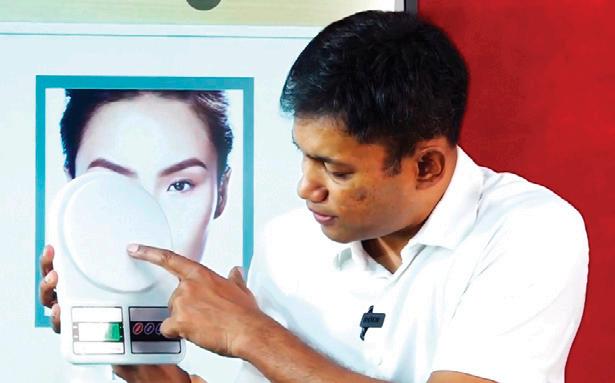
Now maintain this force or pressure. This practice will help you learn the exact amount of pressure needed.

1. Application Technique:
• Place the patient’s head on your lap.
• Press the point below the nose (GV 26/ DU 26 or Hitler’s mustache) in circular motions.
• Use approximately 3 kg of pressure.
• Apply pressure for 2-3 minutes.
• This pressure of 3 kg in circular motion at this particular point helps release hormones like serotonin and beta-endorphin, aiding in faster recovery.
It is advisable to conduct mock drills with a friend to practice the correct amount of pressure. Your mental state and confidence in applying the pressure correctly are crucial during a real emergency.
Staying informed and prepared with the proper knowledge can significantly impact the effectiveness of your response in emergencies. For a detailed study and further understanding of these techniques, refer to the research paper given.
Hu, Xiao-Yang Mio; Trevelyan, Esme; Chai, Qianyun; Wang, Congcong; Fei, Yutong; Liu, Jianping ; Robinson, Nicola. (2015). Effectiveness and safety of using acupoint Shui Gou (GV 26): A systematic review and meta-analysis of randomized controlled trials. Acupuncture and Related Therapies. 3.10.1016/j.arthe.2014.12.001.
Key Points to Remember:
• Keep your Rapid Action Kit ready.
• Practice applying pressure correctly.
• Stay updated through our resources.
To watch the video for Epilepsy & Seizures, scan the QR code
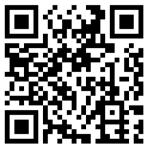
Heart attacks are becoming increasingly common, particularly in the aftermath of widespread vaccination. Four years ago, warnings were issued by me about the potential risks of vaccines leading to heart attacks. The concern is that vaccines may introduce harmful substances into the body, causing blood clots that can lead to a heart attack. This hypoxic (lack of oxygen) condition in the heart results in pain, cellular death, and potentially fatal heart attacks.

• Pain in and around the heart
• Chest pain
• The feeling of pressure
• Radiating body pain towards the left hand, back, or right
• Lightheadedness
• Fainting
• Dizziness
• Vomiting
• Excessive sweating
Recognizing these symptoms early is crucial for timely intervention and treatment.
You can observe three simple steps to help a patient experiencing a heart attack:

If you are the FIRST
• Choose the heart-safe position. This method involves physically bringing the calf muscles closer to the primary heart by adopting specific postures like sitting with knees folded upright. Make the patient sit on the floor with the support of a wall. Avoid making the patient sit on the chair as he may fall down leading to secondary injuries.
• To stop an ongoing heart attack, ginger is the best medicine. Take approximately 20 grams of ginger. The active agent that works like medicine is ‘gingerol’. If the patient is conscious, give him ginger. Ask him to chew it, hold the ginger juice in the mouth and not swallow it. The gingerol will sublingually bypass the first metabolism of the liver and directly enter the bloodstream for immediate effect. Gingerol produces Nitric oxide in our blood vessels which in turn mixes with free radicals and eliminates them. Free radicals creates harmful species that lead to death, and gingerol help stop this phenomenon.
Ginger (20 gms)

ssanien MA. Ameliorating Effects of Ginger on Isoproterenol-Induced
Acute Myocardial Infarction in Rats and its Impact on Cardiac Nitric Oxide. J Microsc Ultrastruct. 2020 May 8;8(3):96-103. doi: 10.4103/JMAU.
JMAU_70_19. PMID: 33282684; PMCID: PMC7703011.
When the patient is unconscious administer Chilli Oil:
• When the patient is unconscious and unable to chew ginger, use chilli oil. Take 1 ml or less in a dropper and administer it sublingually under the tongue. Capsaicin, an active agent found in red chilli, stimulates the cardiac sensory nerve. This also helps the body produce Substance P (SP), an 11-amino acid-long neuropeptide expressed by the central nervous system (CNS), the peripheral nervous system, and immune cells. This substance helps halt the ongoing heart attack and creates a chance of reversing the damage caused.

Location: Sublingually (under the Tongue)
Szallasi A. Vanilloid (capsaicin) receptors in health and disease. Am J Clin Pathol. 2002 Jul;118(1):110-21. doi: 10.1309/7AYY-VVH1-GQT5-J4R2.
PMID: 12109845.
Du Qian, Liao Qiushi, Chen Changmei, Yang Xiaoxu, Xie Rui, Xu Jingyu,
The Role of Transient Receptor Potential Vanilloid 1 in Common Diseases of the Digestive Tract and the Cardiovascular and Respiratory System Frontiers in Physiology 2019


• Stimulate specific points: Apply pressure equivalent to 2-3 kg in a circulatory motion on the points shown in the picture (LI4 & P6) on both hands for 3 minutes. Also, stimulate the wristband point for 3 minutes with the same pressure. This will be a 10-12 minute intervention.
How to Identify Victory Point (LI4)

LI4 acu-point is located on the back side of the hand at the intersection of the bones of the thumb and first finger.
How to locate ‘wristband point’ (P6)

The pressure point P-6 or wristband point is located three fingers’ widths below your wrist crease. To find it:
1. Flatten your palm and place the first three fingers of your opposite hand across your wrist.
2. Place your thumb on the point below your index fingers between two large tendons.
After a total intervention of 12 minutes of acupressure, create a wristband using methi seeds from your Rapid Action Kit as part of the recovery process. Attach it to the wristband point and the V point. Every 2-3 hours, the patient or a family member should stimulate these points. Within 10-12 minutes, blood pressure normalizes, heart rate drops, and oxygen saturation increases. Remember, heart attacks are caused by hypoxic situations due to low oxygen, and stimulating these points reverses this condition by releasing hormones like endorphins and serotonin, which help the patient calm down from the trauma of a heart attack. Importantly, continuous stimulation of these points for the next 24 hours can also prevent future heart attacks.
You can also refer to the research papers shown in the images for a detailed study. By following these steps, you can provide immediate and effective aid to someone experiencing a heart attack.
Batvani M, Yousefi H, Valiani M, Shahabi J, Mardanparvar H. The Effect of Acupressure on Physiological Parameters of Myocardial Infarction
Patients: A Randomized Clinical Trial. Iran J Nurs Midwifery Res. 2018 Mar-Apr;23(2):143-148. doi: 10.4103/ijnmr.IJNMR_83_16. PMID: 29628963; PMCID: PMC5881232.
Ceyhan Ö, Taşcı S, Elmalı F, Doğan A. The Effect of Acupressure on Cardiac Rhythm and Heart Rate Among Patients With Atrial Fibrillation: The Relationship Between Heart Rate and Fatigue. Altern Ther Health Med. 2019 Jan;25(1):12-19. PMID: 30982782.
To watch the video for Heart Attack, scan the QR code

If you are the FIRST RESPONDER! | 43
Brain stroke is a medical emergency that requires prompt recognition and intervention. Identifying a brain stroke early can significantly improve the chances of recovery.
How
• Weakness and paralysis on one side of the body
• Difficulty in talking, slurred speech
• Vision impairment
• Dizziness
• Falling towards one side because of weakness
Cao, Z., Balasubramanian, A., & Marrelli, S. P. (2014). Pharmacologically induced hypothermia via TRPV1 channel agonism provides neuroprotection following ischemic stroke when initiated 90 min after reperfusion. American Journal of Physiology-Regulatory, Integrative and Comparative Physiology, 306(2), R149-R156.
Food as Medicine:
• Chilli Oil: Administer 1 ml or less of chili oil sublingually (under the tongue) using a dropper.
The active agent in chili oil helps stimulate the nervous system and can halt the ongoing stroke. Refer to research papers for detailed information on this intervention.
Pressure as Medicine:
Acupoint : LI 4 & GV 26


LI 4 GV 26
Lina M. Chavez, 1 Shiang-Suo Huang, 2 Iona MacDonald, 1 JaungGeng Lin, 3 Yu-Chen Lee,1,4,5,* and Yi- Hung Chen, Mechanisms of Acupuncture Therapy in Ischemic Stroke Rehabilitation: A Literature Review of Basic Studies.
Without delay pressure as medicine is to be applied. These are the 2 points that should be stimulated i.e. Hitler’s mustache point & Victory point.
• Victory Point & Hitler’s Mustache : Apply pressure to these points simultaneously. These points are crucial for stimulating the production of angiogenic
factors like VEGF, which can halt and potentially reverse the effects of a stroke by enhancing blood flow and reducing anti-angiogenic factors like angiostatin.
1. Stimulate Hitler’s and Victory Points: Apply pressure to both points for 4-5 minutes in circular motion with 2-3 kg pressure.
2. Post-Pressure Application: After stimulation, apply methi strips to the Victory Point.
3. Continuous Stimulation: Instruct the patient to stimulate the Victory Point every 2-3 hours to maintain the effects of the initial intervention.
To watch the video for Brain Stroke, scan the QR code


Nestaas, S., Stensæth, K.H., Rosseland, V. et al. Radiological assessment of chest compression point and achievable compression depth in cardiac patients. Scand J Trauma Resusc Emerg Med 24, 54 (2016).
Cardiac arrest is a critical emergency that can often be confused with a heart attack, but understanding the difference between the two is vital.
Difference between Cardiac Arrest and Heart Attack:
My book The Last 4 Minutes explores this topic in depth.
Cardiac Arrest:
• It is essentially a temporary death. It can be identified by:
• No pulse
• No breath
• No movement
When cardiac arrest occurs, the first 4 minutes are crucial. This period is often referred to as “temporary death” or cardiac arrest. During these first 4 minutes, although the person has no pulse and does not breathe, the body still contains enough reserve oxygen to allow for potential revival. From 4 to 10 minutes, there is still a window of opportunity to revive a clinically dead person.
Understanding these critical moments can significantly improve emergency situations, offering a chance to save lives through timely and effective intervention.
Pressure as Medicine which is most important here is ‘Cardiac Chest Compression’ (CCP)
Step-by-Step Guide for cardiac chest compression:
1. Locate the Pressure Point:
• Find the intersection between the sternum (breastbone) and the middle of the nipple line.
• Move 3 cm to the left of the patient from this intersection point. This is your compression point. Applying pressure here targets the ventricles of the heart.
2. Apply Cardiac Compression:
• You need to perform compressions to a depth of 5 cm.
• Maintain a rhythm of 100-120 compressions per minute.
• Continuous compressions are crucial. Do not stop; any break will cause the pressure to drop back to zero, reducing the chances of revival.
3. Achieving Effective Compression:
• Your goal is to bring the systolic pressure above 20, which significantly increases the likelihood of revival by reactivating the circulatory system.
• Each compression should be 1-2 strokes per second up to 5 cm depth which can effectively maintain a pressure gradient of 20 mmHg.
4. Correct Posture:
• To ensure proper technique and posture during compressions, scan the QR code given at the end of this topic to watch a demonstration video.
• Practicing on a mannequin is essential to avoid damaging a live person’s heart during training.
5. Team Effort:
• CCP can be exhausting; one person can typically sustain it for about 2 minutes before becoming fatigued.
• A second person should be ready to take over without delay.
• In some cases, CCP must be continued for up to 20 minutes to revive the patient successfully.
• If there is no revival after 20 minutes of continuous CCP, the chances of survival are extremely low.
• Continuous, uninterrupted compressions help build and maintain the necessary pressure to sustain minimal blood flow and oxygen delivery to vital organs. Avoid mouth to mouth breathing as this breaks the building of pressure gradient due to compressions. And one has to restart the compressions to achieve 20 mmHg of pressure gradient.
• The technique increases the survival rate to 76% when performed correctly and without interruption.
• Practicing CCP techniques in advance is critical to ensure readiness during an emergency.
• Use a mannequin for practice sessions as a live person’s chest will be hard to compress as it has
| If you are the FIRST RESPONDER!
enough pressure to sustain life and also to avoid harming him.

Understanding and effectively performing Cardiac Chest Compression (CCP) during the crucial first 4 minutes of cardiac arrest can make a life-saving difference. Proper training, continuous practice, and readiness are key components to handling such emergencies successfully.
In addition to the CCP, a third person can apply pressure to Hitler’s mustache point using a circular motion for 2-3 minutes. Stimulating these points enhances the production of the ‘nitric oxide’ which in turn revitalizes the body and chances of revival increase. This chemical reaction can halt the ongoing cardiac arrest and potentially reverse its effects.
Ceyhan Ö, Taşcı S, Elmalı F, Doğan A.
The Effect of Acupressure on Cardiac Rhythm and Heart Rate Among Patients With Atrial Fibrillation: The Relationship Between Heart Rate and Fatigue. Altern Ther Health Med. 2019 Jan;25(1):12-19. PMID: 30982782.

If all else fails AED (Automated External Defibrillator) is used to revive the patient. For more details read:
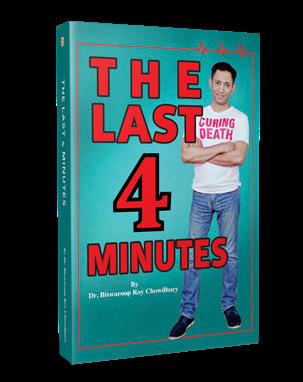
Free ebook available at www.biswaroop.com/ebook
To watch the video for Cardiac Arrest, scan the QR code

| If you are the
Tachycardia (Heart Rate > 100)
Tachycardia is the medical term for a heart rate exceeding 100 beats per minute. Various irregular heart rhythms, known as arrhythmias, can lead to tachycardia.
How to Check Pulse Rate on the Wrist

1. Place the tips of your index and middle fingers on the inside of your wrist, below the base of your thumb.
2. Press lightly until you feel the blood pulsing beneath your fingers.
3. Use a watch or clock. Count the beats you feel for 1 minute, or count the beats for 15 seconds and multiply by 4.
Tachycardia can lead to a heart attack, and the symptoms are similar. It’s important to note that an increased heart rate due to physical activity is not considered tachycardia. It becomes a concern when the heart rate rises under normal resting conditions.
Symptoms of Tachycardia • Weakness • Dizziness • Sweating • Breathlessness
• Slight pain in the chest area
Protocol
Pressure as Medicine: Modified Valsalva Manoeuvre
Appelboam A, Reuben A, Mann C, Gagg J, Ewings P, Barton A, Lobban T, Dayer M, Vickery J, Benger J; REVERT trial collaborators. Postural modification to the standard Valsalva manoeuvre for emergency treatment of supraventricular tachycardias (REVERT): a randomised controlled trial. Lancet. 2015 Oct 31;386(10005):1747-53. doi: 10.1016/ S0140-6736(15)61485-4. Epub 2015 Aug 24. PMID: 26314489.
If you are the
The Modified Valsalva Manoeuvre technique is a universal method used in hospitals and can be learned for home applications. This intervention aims to reduce the pulse rate below 80 beats per minute to bring the patient into a safe zone.
This technique was discovered in 2015. For more details, refer to the REVERT Trial research paper.
1. Prepare the Syringe: Take the syringe from your Rapid Action Kit and pump it a few times to loosen it up.
2. Create Lung Pressure: The objective is to create pressure in the lungs to normalize the high heart rate. In the first 15 seconds, you must generate pressure while the patient remains sitting. This process typically requires 2-3 people to assist.
3. Blowing into the Syringe: The patient needs to blow into the syringe with enough pressure to move the plunger backwards. Blow continuously for 15 seconds.

4. Position Adjustment: Immediately after the initial 15 seconds of blowing into the syringe, lay the patient down and elevate his legs to about 45 degrees. Maintain this posture for another 15 seconds.

5. Check Heart Rate: After 30 seconds, check the heart rate. The success rate of the modified Valsalva Manoeuvre in reducing the heart rate below 100 is approximately 50%. So that means
If you are
Ceyhan Ö, Taşcı S, Elmalı F, Doğan A. The Effect of Acupressure on Cardiac Rhythm and Heart Rate Among Patients With Atrial Fibrillation: The Relationship Between Heart Rate and Fatigue. Altern Ther Health Med. 2019 Jan;25(1):12-19. PMID: 30982782
Stimulating Wrist-band Point:


You can also utilize circular wrist pressure and a methi strip band on the wrist to help regulate heart rate.
If you are the FIRST RESPONDER! | 57 you will need to repeat the process for appropriate relief. Simultaneously you can initiate stimulating wristband point (P6) with methi/ fenugreek strip.
The patient should apply pressure to the point every two hours. The methi seeds attached to the white tape also exert pressure. Repeat till appropriate relief is achieved.
All these techniques are evidence based and followed at our HIIMS hospitals. Fastest, safest without any damage to the patients and also economical.
To watch the video for Tachycardia, scan the QR code

| If you are the FIRST
Motion sickness occurs when there’s a disparity between the movement perceived by your eyes and the signals your inner ear receives. This dissonance can lead to symptoms like dizziness, nausea, and vomiting. Common triggers include cars, trains, airplanes, boats, or amusement park rides.
Megan Crichton, Skye Marshall, Elizabeth Isenring, Anna Lohning, Alexandra L. McCarthy, Alex Molassiotis, Robert Bird, Catherine Shannon, Andy Koh, Ian McPherson, Wolfgang Marx,Effect of a Standardized Ginger Root Powder Regimen on Chemotherapy-Induced Nausea and Vomiting: A Multicenter, Double-Blind, Placebo-Controlled Randomized Trial,Journal of the Academy of Nutrition and Dietetics, Volume 124, Issue 3, 2024,Pages 313-330.e6, ISSN 2212-2672,
Consume 10 grams of ginger by chewing it. Ginger contains polyphenols that interact with multiple
signaling molecules in the body, relieving multiple medical conditions. Its effects last for approximately 2-3 hours, necessitating regular consumption of ginger every couple of hours.
For a deeper understanding of the underlying science, please refer to the research paper in the image.
Step 2: Pressure as Medicine
Intervention - Acupoint Wristband (P6) Stimulation
• Stimulate the Acupoint P6 in a circular motion, as previously learned.
• Create a wristband with methi seeds and wrap it around the P6 point of both hands.
• Apply pressure to the P6 point whenever you feel motion sickness.
• Chew ginger along with this for added effectiveness.
To watch the video for Motion Sickness, Nausea and Vomiting, scan the QR code

If you are the
Nikkhah Bodagh M, Maleki I, Hekmatdoost A. Ginger in gastrointestinal disorders: A systematic review of clinical trials. Food Sci Nutr. 2018 Nov 5;7(1):96-108. doi: 10.1002/fsn3.807. PMID: 30680163; PMCID: PMC6341159.
Aregawi LG, Shokrolahi M, Gebremeskel TG, Zoltan C. The Effect of Ginger Supplementation on the Improvement of Dyspeptic Symptoms in Patients With Functional Dyspepsia. Cureus. 2023 Sep 27;15(9):e46061. doi: 10.7759/cureus.46061. PMID: 37771933; PMCID: PMC10525921.
• Take 10 gms of ginger and chew it.
• Polyphenols in ginger target multiple signaling molecules, acting as medicine for various conditions.
• Effects last 2-3 hours, so chew ginger every couple of hours.
• Helpful for menstrual pain; refer to the research paper for scientific details.


Nani, Desiyani & Maryati, Susio & Rahmaharyanti, Rizka. (2015). Effect of acupressure therapy point HT 6 and LI 4 on post cesarean section’s pain. International Journal of Research in Medical Sciences. S119-S122. 10.18203/2320-6012.ijrms20151531.
Chao, Hui-Lin & Miao, Shang-Jun & Liu, Pei-Fen & Lee, Henry & Chen, Ying-Miao & Yao, Chung-Tay & Chou, Hsiu-Ling. (2013). The Beneficial Effect of ST-36 (Zusanli) Acupressure on Postoperative Gastrointestinal Function in Patients With Colorectal Cancer. Oncology nursing forum. 40. E61-8. 10.1188/13.ONF.E61-E68.

• Apply pressure to the Victory point in a circular motion for 2-3 minutes.
• Utilize a methi strip on this point and stimulate it every 2 hours.
• Effective for generalized pain.

• Locate ST36 below the knees, using four fingers to measure and mark.
• Apply pressure for 6 seconds, release for 2 seconds, and repeat on both legs.
• Alternate legs every 5 minutes for a total intervention time of 25 minutes.
• It is known as the fastest drugless intervention with no side effects.
Scientific Reference:
• Refer to medical references for detailed scientific explanations.
Rapid Action Kit:
• Encourage carrying an image of these points in a portable Rapid Action Kit.
• Suitable for use in various settings such as cars, homes, schools, and hospitals.
• Demonstrated effectiveness in hospital settings with consistently positive results.
To watch the video for Abdominal Pain & Menstrual Pain, scan the QR code

| If you are the
Symptoms of Asthma Attack
• Shortness of breath
• Persistent coughing
• Skin turning bluish
• Dizziness
Hamidpour, Rafie; Hamidpour, Soheila; Hamidpour, Mohsen & Hamidpour, Roxanna. (2019). The Effect of Camphor Discovery for Treating Asthma Corresponding author. Biotechnology Advances.
Intervention: Bhimseni Kapur (Camphor)
• People accustomed to inhalers find relief by using their pumps, but others can use Bhimseni Kapur (Camphor).
• Prepare a powder of Bhimseni Camphor and store it in your Rapid Action Kit.
• Sniff from both nostrils for 10 minutes.
• This is Non-toxic with potent bronchodilating and anti-inflammatory effects.
• It helps reduce airway inflammation.

Acupoint : LI 4 & ST 36 LI 4 ST 36


Maa SH, Wang CH,Hsu KH, Lin HC, Yee B, Macdonald K, Abraham I.
Acupressure improves the weaning indices of tidal volumes and rapid shallow breathing index in stable coma patients receiving mechanical ventilation: randomized controlled trial. Evid Based Complement
Alternat Med. 2013;2013:723128. doi: 10.1155/2013/723128. Epub 2013 Apr 23. PMID: 23710234; PMCID: PMC3655565.
Apply pressure to three specific points:
1. Victory point (LI4)
2. Wristband (P6) acupoint
3. ST36 below the knees
4. Utilize techniques from previous interventions to stimulate these points effectively.
After stimulation, wrap with methi strips and continue stimulating every 2 hours for sustained relief.
To watch the video for Asthma Attack, scan the QR code

High blood pressure is common and often managed with medications. But Pressure as Medicine offers a fast, side-effect-free alternative.
Lin GH, Chang WC, Chen KJ, Tsai CC, Hu SY, Chen LL.
Effectiveness of Acupressure on the Taichong Acupoint in Lowering Blood Pressure in Patients with Hypertension: A Randomized Clinical Trial. Evid
Based Complement Alternat Med. 2016;2016:1549658. doi: 10.1155/2016/1549658. Epub 2016
Oct 10. PMID: 27803727; PMCID: PMC5075632.
Protocol
Pressure as Medicine
1. Taichong Acupoint:

• Measure two fingers down from the thumb of your foot.
• Stimulate this point in a circular motion for 3 minutes on each foot, totaling 6 minutes.
2. Results from Randomized Control Trial:
• After 6 minutes, BP dropped by an average of 15 mmHg.
• After 15 minutes, BP was reduced by 20 mmHg.
• After 30 minutes, BP decreased by 25 mmHg.
• Faster than medication with no side effects.
• The effect lasts 2-3 hours; repeat stimulation as needed.
3. Trial Details:
• Conducted on individuals with BP above 150/90 mmHg.
• BP stabilizes after reduction.
4. Long-Term Use:
• It is not necessary to continue lifelong; a few days of stimulation may normalize BP.
5. Cost and Convenience:
• Free, rapid, and accessible without spending money. To watch the video for

Conclusion:
This book provides safe, chemical-free methods for treating emergency situations for yourself and your loved ones. The pressure points mentioned are versatile and can be used for various purposes.
To become proficient in these treatments, watch the tutorial video multiple times and memorize all the protocols.
Those interested in in-depth learning and university certification should join our ‘3-month online Certification in Integrated Medicine (CIM)’. Lifestyle diseases like cancer and chronic kidney diseases can be effectively and safely treated at home using Food as Medicine and Pressure as Medicine. To join online course, go to:
www.hiimsmedicalacademy.com
Go to www.coronakaal.tv to watch success stories of patients who have cured themselves by following our methods. GRAD, DIP diet and 3 step flu diet, which has been clinically proven to cure diseases like hypertension, CKD, diabetes, all kind of influenza like illness (Flu/ COVID-19) and more.
The most crucial step is to create a Rapid Action Kit and always keeping it with you. If you cannot make one, you can purchase one from us at:
www.biswaroop.com/shop
70 | If you are the FIRST RESPONDER!

Join our comprehensive program in ‘Integrated Medicine’ which will empower you to become your own doctor. Whether it's lifestyle diseases, infectious diseases, emergency care, or pain management, this course will equip you to create an integrated emergency toolbox at home to meet these targets. to take charge of your health and well-being and start your journey towards self-su�ciency in health management.
Course Material: The course material, includes books which will be delivered to your doorstep via courier (within India) and e-books will be shared through email.
Mode: Weekend Online / Correspondence
• DIP Diet
• 3 step flu diet
• GRAD
• Circadian chart
• Zero Volt Therapy
• Acupressure
• Ayurvedic Panchkarma
• Vaso-Stimulation Therapy






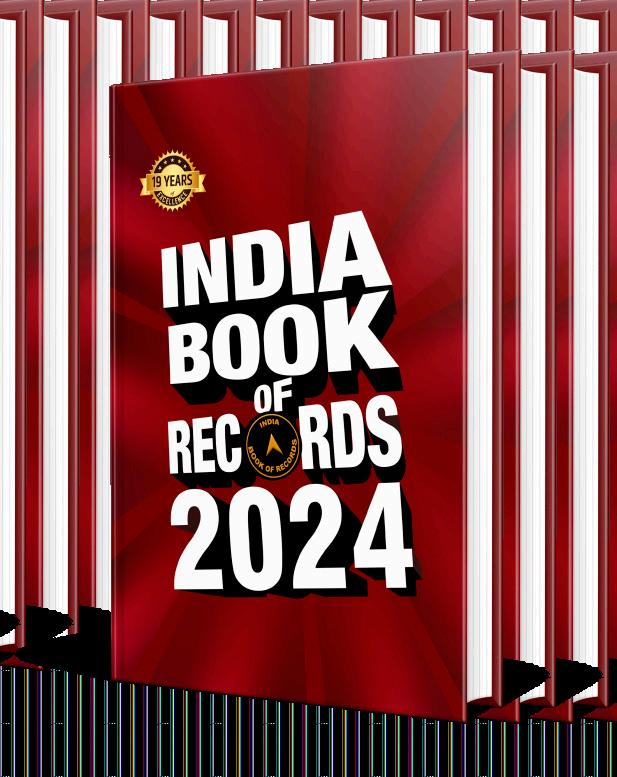



Ÿ Foot Mat (19 x 12 inch)
Ÿ Earthing Copper Rod
Ÿ Connecting Copper Wire (10 meter)
Ÿ Continuity meter
Ÿ Carry Bag
To

Ÿ Bedsheet (75 x 36 inch)
Ÿ Earthing Copper Rod
Ÿ Connecting Copper Wire (10 meter)
Ÿ Copper connecting wristband
Ÿ Continuity meter
Ÿ Carry Bag

Ÿ Yoga Mat (74 x 30 inch)
Ÿ Earthing Copper Rod
Ÿ Connecting Copper Wire (2 meter)
Ÿ Continuity meter
Ÿ Carry Bag
Neerja Roy Chowdhury



· Overcome absent mindedness · Memory techniques to achieve career goals





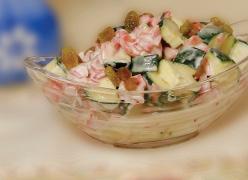


Step 1 Open the cap Step 2 Sniff the oil

The box contains: • 2 Seconds Oil bottle • Cer tificate of Commitment

If you have decided to pick only one of my suggestions for the sake of your health, then take this suggestion:
Stop consuming tea specially, morning tea. The early morning tea makes the inner lining of your intestinal wall acidic, as after a long night of fasting your stomach is empty and craving for food. An acidic stomach on a regular basis is the single biggest cause of all kind of inflammatory and lifestyle diseases including arthritis, Diabetes etc.
How to stop craving of tea Switch to Hunza Tea
Hunza Civilization: Hunza people are the Indians living at extreme northwest of India in Hindu Kush range. They are known to be one of the world's healthiest civilizations, often living up to the age of 110 years.
Ingredients:
* 12 Mint leaves(Pudina)
* 8 Basil Leaves (Tulsi)
* 4 Green cardamom (Elaichi)
* 2 gm Cinnamon (Dalchini)

Instructions:
* Take 4 cups of water in a tea pan
* Add all ingredients, simmer it for 10 mins
* Add a dash of lemon juice and serve hot or cold
For those who are too lazy to collect the above ingredients (to make their own hunza tea) may order You may place your order at:



This hot water utensil with an electric panel is a part of hot water Vaso-Stimulation Therapy. Before connecting the VST Kit with the electrical socket one must check the earthing of the socket. To check the earthing use the Dr. BRC Earthing Detector included in this kit.
For full understanding of VST Kit read the book H.E.L.P. (www.biswaroop.com/help)







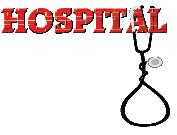



































































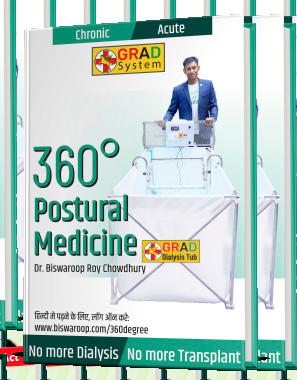


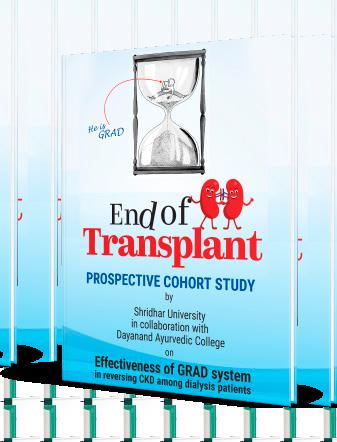











In this evidence based pocket guide, Dr. Biswaroop Roy Chowdhury employs an integrated medicine approach to address common medical emergencies such as hear t attacks, heat strokes, motion sickness, cuts and bleeding, epileptic es, and various types of pain. The book encourages eaders to create their own apid Action Kit” to use as st aid in life-threatening situations. For better understanding, video links and QR codes are provided inside the book for each of the 16 emergencies.
